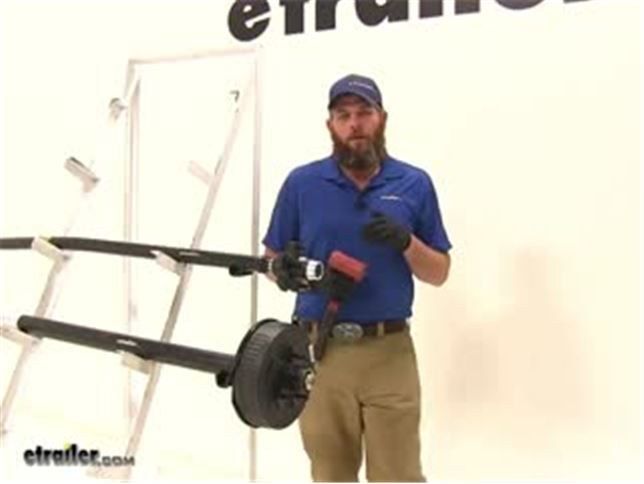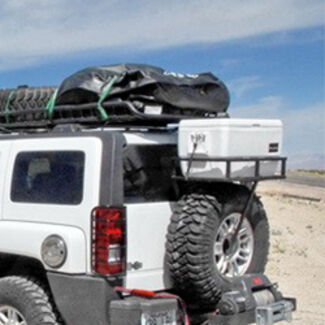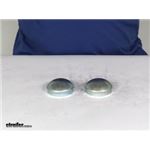Trailer Hub Grease Cap, 2.72" OD Drive In - Qty 2

Thank you! Your comment has been submitted successfully. You should be able to view your question/comment here within a few days.
Error submitting comment. Please try again momentarily.
- All Info
- Reviews (33)
- Q & A (0)
- Videos (2)
- Photos
Redline Trailer Bearings Races Seals Caps - RG04-100
- Caps
- Standard Grease Cap
- 2.717 Inch O.D.
- Redline
Trailer Hub Grease Cap, 2.72" OD Drive In
- Quantity: 2



Videos are provided as a guide only. Refer to manufacturer installation instructions and specs for complete information.
Video Transcript for Trailer Bearings Races Seals and Caps Rebuild
Speaker 1: Today we're going to take you through the rebuild process on a couple of hubs. We've got an idler hub, and here we've got a hub and drum assembly. Works with electric rigs, but this can also work for just standard discs, if you've got a disc brake style setup.Basically what we're going to show you is how to get all of the bearings out. How to remove the seal. How to remove the race's if they're damaged, then get them replaced in the proper manner. We'll show you how to use an easy loop hub, which we have here.The first thing we are going to need to do is, get the grease cap off the end.
It can have either a rubber plug in it like this one does, or it can be a solid metal cap.These are pressed fit in there, basically by tapping on them on the back side. To remove them, a deadbolt hammer is typically what we're going to use. We're just going to start tapping as we go around. You'll see a little separation start right here, and slowly it'll work it's way off.Now the next step's going to vary a little bit depending on your axle setup. Do you see this is going to have a keeper that goes around the nut.
And that prevents that from being backed off, or removed. A lot of times you'll have a castle nut, which will have just little tabs that stick off, and there will be a cotter pin that passes through it. Just depending on your application, you need to get the keeper for the nut off. This style we just kind of pry out. A cotter pin you would just remove of course.Once we have that off ...
We'll start to take off the nut here, and the washer that's in behind it. Now yours should look a whole lot more dirty than this. There should be a lot of grease packed in, and through the hub, this one's brand new. We thought it'd be nice to show you the components before the grease was on .. Of our washer that comes off.And then here we're going to have our outer bearing.
Continue to pull that. We're gonig to have our inner bearing here. That sits in the backside of the hub. And we didn't put it in yet, we will show you how to put it in. But a seal would typically be covering the backside here. We'll show you how to use a seal removal tool, or another tool. To get that pried up and out. To get an access to that inner bearing.Now for a drum style like this, that process for disassembly is going to be just the same. One thing to keep in mind if you're using a disc brake setup. You'll have to remove the caliper before the disc is going to come off.Now once we have the spindle exposed, as we said this is going to be really greasy. We want to get all the grease removed, and the first thing we'll do is inspect it. We want to make sure that it looks just like what we have here. Everything's nice and smooth. We don't see any kind of discoloration, or any marring on the metal. Indicating that our bearing's got hot.If you do have any of those symptoms, at this point it's time to replace those bearings. You don't want to repack them. Get new bearings, and put in there. You might have a bearing that's come apart in here. Another surface to ensure is in good condition, is where your seal is going to go. That helps seal all the grease inside of our hub. With a damaged or broken seal, that grease is going to seep out. Either out of the hub, or in this case into our brake assembly.Now if your axle has brakes, we're also going to check the disc. Make sure it doesn't have any issues, or your hub. And this is going to be a hub and drum assembly. The brakes are going to ride on this machine surface. You're going to check that for signs of excessive heat, discoloration, or cracking. And this is our magnet surface. We'll check that surface for the same issues.Now inside the hub regardless if it's a disc brake, it's a drum brake like this. Or just a standard idler style hub. You're going to have an outer race. Would be right here, it's a small tapered piece of metal your bearing sits in, and rotates on. That's basically the outer portion of the bearing.You have the same thing here on the backside. This is called the inner race. Now if those show any signs of wear, overheating, or cracking. Those are also something we'll need to replace, which we'll show you how to do in just a minute.Now, with your brake assembly exposed, if you do have electric brakes like we have here. It's a good idea to check all the components for wear, cracking, maybe missing pieces. Check your pad thickness to make sure those are in good shape. Basically if you have a non working brake assembly and you put everything back together, you're just going to have to take it apart and do it all over again to get back to the brake assembly. This gives you a really good option to be able to change them out.And most applications are going to use a four, or maybe a five bolt flange to hold them in place. And you'll just remove the lock nuts, or sometimes you'll have a hex nut with a lock washer. You want to remove those, and then simply slide your assembly off after you cut the wiring.The friction material itself should also be checked for any kinds of cracking, or overheating. If you have any grease inside the system at all, it's likely it's gotten on those pads. It's a good idea to get those changed. Now as far as the removal of the races go, it's going to be just the same whether we're using an idler style hub like we have here. A drum brake like we have here. You can basically see where the idler is, here in the middle of the hub. It's going to go all the way around there, and we just have this extra material here to provide our braking surface.Now if you're doing a disc brake style job again, it's going to be just the same here with the races living inside of the actual hub portion. You'll just have the discs there for the brakes to make contact. We're going to use this little bit smaller one, it's a little bit easier to manage to show you how to get these out. We've talked about where the races are. The outer here, the inner being closer to the inside, but on the backside of the race there's a little lip. That lip's meant to stick out just a little bit further than the hub, and provide us an area to put our tool on, and help to drive that out.If you look all the way through there on that inner race, you'll see that little lip that sticks out just from the hub slightly, and it gives us enough area to use our tool on. Now generally to remove these you're going to use a punch, similar to this. Some guys will use a screwdriver. Or a piece of pipe. If you have a piece of pipe that's small enough to fit inside of that diameter, you can take that down through and allow it to rest on that lip.Use our punch, and then just need a hammer. And we'll start working that out. We're going to tap all the way around. Kind of equally, and evenly apply the force to get it to come on out of the bottom for us.You can see now as it starts to come out there's going to be a little gap created between the hub and the race. And we can just keep going, bringing it on out. Then you can inspect the inside of the hub surface there. Make sure no damage or anything has occurred, and repeat that same process for the outer race if you plan on removing and replacing that one.Now in the outer flat edge, you can see we're going to have our tapered edge on this side. If we roll our race over to the flat side, typically there's going to be a manufacturers part number on there. That will help you identify which race it is, that you need to go back in your system. If those are rubbed off, worn off, if you can't read them. You can measure the outside, to outside diameter of the race here. It's a good idea to use a micrometer to get it exact.Now here's your basic micrometer. And again, the outside of the race is what we're going to need to measure. You want to go . I set the thickest point there. Looks like this one's going to be about 1.98. That's going to be the measurement you'll want to supply.Now while we've got this out, let's also look at the proper way to measure our bearing. Instead of the outside for the bearing, we need to measure the inside diameter. That's going to be pretty simple. Let's pull that out, find the largest measurement we can. Which here, looks like it's going to be 1.03. With that information, we'll be able to get the correct bearing, and the correct race, so they'll fit together properly and make a full bearing kit for us.Now here's the race, we're going to show you how to get this put back in. Basically just going to press fit inside of our hubs. We need to get it down on there. Kind of like that. And you'll have a couple options. A lot of times you're going to see do it yourself or at homer, just going to use a wooden block. Just place it on there. That's going to get you started, but at that point you'll struggle in getting it to go all the way down into it's seat.Now to take care of that problem, there are several seal drivers that are available. Seal and race drivers that are available out there on the market. It's designed to fit down inside of our race, inside of our hub and get it down there where it needs to go. This is part number ptw83020, has several different sizes, even if you have multiple trailers it's going to do the job.Now the side with the angle on it, is designed to fit down inside of our race. If we use the other side, that's going to be for driving your seal into place. Just want to hold it, and take it on in with your hammer. You'll see, you just want to insure that our race is all the way up against that line on the hub where it's supposed to mate to.Now when it comes time to pack your bearings you're going to have several different ways of doing this. You can just use your hand, is the traditional method. That's going to be the method probably reserved for the very occasional trailer work kind of situation. If you do it once or twice a year, probably get away with it that way.Next you would go to a, kind of a sandwich funnel style almost. If you look inside of there, you can see the bearing. It's located between the two pieces. Just use a grease gun. Start filling that with grease, and that's going to fill our bearing for us. And the third, with this one you're just going to place your bearing down and in. It should be pretty close to center. And then we've got our cone her that's going to go down and secure that.Now I think this style, wastes a little bit more grease than what this style will. This has a dust cap. You can see, you can keep your grease in there, put your dust cap on there and save it for later use. This will be if your going to do it every couple years. And this particular style would be if you're a more regular user.Let's start by showing you how to use a bearing packer. Similar to this. Again, we've just got our grease inaudible 00:11:07 here on the top. And then just slowly start to fill it. Now I like this style quite a bit. I think even regular users might enjoy it, because you can get a really quick visual look at that bearing. You're not going to have to overdo it, or have to much grease.You can kind of see in there now, we're starting to get grease to come out of it. Couple more pumps, we'll be good. You can see we've got grease coming out all the way around. Where all of our bearings are. Got a little bit of excess there. Just take that around the outside of it. And then we should be able to lift it off. And now you can see what we we're talking about. Just a little bit of excess there, that you're just going to wind up wasting.Now we'll take our bearing, we're going to place it right down in our race. And then we'll cap off the back with our seal. Right now our seal's going to fit in just like our race did. It's going to have a little bit of a pressure fit to it. Now very often in this situation, I see people using the four by four method. Kind of here, just placing that on and tapping it. As an option though, if you do have one of these. You can see that's designed to fit right on the top of the seal. And help drive it in.The biggest thing here is, just going to be getting it driven in squarely. You can see, this side's in a little bit further than this side. I'm going to start this side first. Now since we didn't have the opportunity to show you before, we're going to take a look at pulling a seal. Now this is a seal puller, we carry this on our website part number ptw1219. This is meant to hook underneath the seal. And then you kind of pull up on it, and just like our race you'll have to work all the way around that edge. Just bringing it out a little at a time.If you don't have that available. Another option would be a screwdriver. You just kind of get that under the seal, and turn it. And see, that'll allow you to also pop that out. We've taken care of our race. Our inner bearing. Our seal. The last component, before we put our hub back in place is going to be our outer bearing. Now with this bearing, I'll show you the hand packing method.This is definitely . Slightly dirtier method than the bearing packer. When we get grease on our hand we want to look at the larger side of the bearing. This is the smaller side. We have a larger side In between the inside and outside there's a gap. We can see our rollers in there. We want to grab that, and use that gap and shove grease inside of it. Now this is going to take a little bit, you want to work in the same spot until you get the grease pushed all the way through. We can see on the top there we've got a little bit starting to come through.And once we push it in the bottom, and you see it start coming out the of the top in those little drips, it's going to indicate that, that section's fully packed. Just need to work all the way around their outside edge now and do the same thing. Alright, once that's all the way around . The bearing will be ready for use.Now one more thing I like to do. We can see our inner bearing there, and our outer bearing. Well between the two, got a pretty big gap in there. If you'll take a . Pretty good amount of grease. We're just going to go all the way around. See how we can go all the way around the inside and just line that really well. The more grease we have in here, the less chance we have of any moisture getting in there, which can cause corrosion, rust, pitting. Pretty much things we do not like when it comes to bearings, races, and hubs.Put plenty of grease in there. And then this one does have the easy lube spindle, that'll even fill it in more. Now we can get our assembly slid on. I like to keep my thumbs on that outer bearing, just to prevent it from . inaudible 00:15:28 pushed off there. Now we can put on the original hardware that we removed, in taking off our hub the first time. In our case, we had our washer and our nut.Now most commonly you'll see pliers similar to this being used. We basically want to get that tightened down. Once it's fully tightened down you'll feel some resistance in the hub. We back it off just slightly. That'll give us a little bit more freedom of motion there. Something you don't want however . Is any movement in, or out on your hub. You want to be sure that everything is compressed, and you don't have what's called end play. Which would be the play in and out.Once we've got that set, then you'll put on whatever tight keeper yours came with. Get that put back in place. Now with an easy lube style hub, you're going to place your grease gun on the end, and then you can just fill the remainder of that hub up.Now for your typical applications, you're either going to have a solid cap, or a cap that'll have a rubber plug in it. A solid cap's going to be for an axle without the grease inaudible 00:16:51 here on the end. Goes on there. Just knock it on with your rubber mallet. Same with the one with the plug. Just gives you a removable area there, be able to cap that off.We'll show you how to put that on. Now as alternatives as well, a lot of times on boat trailers and marine kind of situations. You'll see a bearing buddy. This is going to apply a little bit of pressure on the grease, you'll fill it up. This kind of comes out just a little bit. That applies constant pressure on the grease to make sure we don't have any air, or anything like that. Then there is also an oil bath hub available. Now this is going to be for use with seals that are going to be designed specifically for oil bath use. You'll have to change that seal.We're using a double lip seal. There are also single lip seals available. Of course a double lip seal is going to give you just a little additional security. Keep that in mind when you order. But let's get this knocked on there now so you can see how that works. We just want to take the cap, we're going to center it. This is going to be very similar to what we did with the seal. And then just gently start tapping it around the outside. And it'll seep down on there for you.It's really going to be the same thing that you'll do with any of the end caps. Now with this side done, it's a good idea to take care of all the other hubs. Get them all on the same maintenance schedule. And as long as you'll periodically check the grease, take your trailer out for a trip occasionally. Just to keep everything lubricated. It should extend the life of these parts, and give us years of good service.
Customer Satisfaction Score:
93% were satisfied with this product
7% of customers were not satisfied
- Did not arrive in time
Customer Reviews
Trailer Hub Grease Cap, 2.72" OD Drive In - Qty 2 - RG04-100
Average Customer Rating: 4.8 out of 5 stars (33 Customer Reviews)
Last week I started thinking about my kayak trailer and what repairs needed to be completed before the spring and summer usage.
In 2011 I converted a small sailboat trailer to a two place kayak trailer. I ordered bearing kits wheels and tires at that time from e trailer. Every year I pull the wheels and grease the bearings and I install new grease seals. Last year when I was doing my maintenance I found that the bearing races were lightly rusted and pitted because the trailer was buried under a large snowfall. The bearings were fine and I cleaned up the races with steel wool. I decided I would replace everything come winter. I ordered bearing caps to replace my old dented caps hoping that this will keep the bearings dryer. I made a place in the garage to keep the trailer from the weather.
I placed a call to you guys and was greeted by a very friendly voice on the other end of the phone. Brandon was able to find my past order saving me time and effort. (My filing system could be better.) He was able to e-mail me copies of my previous orders and shortly there after I placed my order on line for new bearing kits and a few extra seals and well you know the rest. I tell everyone about the excellent service I get from etrailer.com.
keep up the good work.

Great service

James

11/23/2023
Very helpful, good product,would purchase again from this company
Arrived very quickly, looks like it will work as described.

Jerry

11/27/2022
When I went to install the caps they would not go in , so I had to go to my bench grinder and grind off a small amount of metal so I could install it on the hub.

Prefect fit for my M1101 Military Trailer. Quick shot of paint and it looks factory.
Perfect fit. Fast delivery.
Good quality grease cap. Matches the cap that I lost off my Military trailer and is better then the grease cap I purchased from Napa, which was a little thin.
Highly suggest these caps vs. what I have found locally.
quality parts .. great staff , it's always a pleasure to do business with etrailer .. fast shipping and low prices.. thanks George , lookin forward to many more transactions with this company..

The hub covers did just fine, however I ended up getting a whole new axle, so i didn't really get to use them. That was now fault of your's though. Thanks.
Andrew F
Excellent products and the web site is very easy to navigate through. The products they sell are of great quality and durability and affordable. shipping is fast and reliable. Being able to see the products and all the information is a lot of help when searching for parts.. Robert B.
Good steel dustcover caps. Needed the high dome cap to clear the nut. Very pleased. Fast shipping. Good customer service. Will use again. Joel in Iowa
Dust caps fit perfectly! Would order from again
Wonderful service ! etrailer is my go to company for parts!
Same as original, needed when I repacked the wheel bearings. Fast shipping.
wrong size for the 2nt time. look up my name in your orders. i will give you one more chance


Katrina B.
7/6/2022
To pick out a grease cap you would need to measure the diameter of the bore of your hub where the current cap is so that we can pick you out the correct replacement.

Great fit replaced missing originals. They have stayed put over a year now, over some pretty rough gravel roads. I'd order these again.

One flew off in the first trip out the door and the others are still there to this day

excellent products very satisfied with the purchase, highly recommend
The kit arrived quickly and in good condition. All of the parts fit perfectly and I was able to assemble my hub in less time than I had planned for.
Very good quality parts very happy with purchase
They fit perfectly
See what our Experts say about this Redline Trailer Bearings Races Seals Caps
- Wheel Trim Options and Grease Caps for a Vintage TrailerA hub cap is going to cover the whole wheel in many cases whereas a grease cap only covers the hub bore so it is much smaller. Think of it as a hub cap covering the whole hub and a grease cap just covering the open end on the hub. A good look for a vintage trailer would be the Americana Baby Moon Trailer Wheel Center Cap, # AM90086. It fits 13 to 15 inch conventional wheels. However, the chrome plated steel may be too much flash for what you are going for. If you want the wheel appearance...
view full answer... - Grease Caps For Hubs on Lippert 7,000 lb AxlesWe have grease caps for a 7,000 lb Lippert axle (including torsion axles), though I do need to say that grease caps are are drive-in, and oil caps are screw-in. I verified with Lippert what the correct grease cap is for their 7,000 lb axle, which is the following: - Standard Grease Cap: Trailer Hub Grease Cap # RG04-100
view full answer... - Electric Drum Brakes To Hydraulic Disc Brake Conversion Kit For 7,000-lb AxlesThe best electric drum brake to hydraulic disc brake conversion kit we offer for 7,000-lb axles, is the HydraStar Disc Brake Kit w/ Actuator for Tandem Axle Trailers # HSE7K-T1. This kit has everything you need to switch your trailer's brakes to disc, and, includes the hub-and-rotor assemblies with bearings, races, and seals. You'll also need grease caps, you can use the Trailer Hub Grease Cap, 2.72" OD Drive In # RG04-100.
view full answer... - Available Grease Caps for Threaded Trailer Hubs With an Inner Bore Diameter of 3-5/8-InchesIt sounds like you may be looking for Bearing Buddys that will fit your threaded hubs. The standard drive-in grease caps you referenced, part # RG04-100, fit a non-threaded hub bore of 2.72-inches, a good bit smaller than yours. The standard grease cap nearest to your size is part # F001603 which fits a non-threaded hub bore of 3.882-inches. Bearing Buddy grease caps are available in sizes for hubs up to 2.717-inches inner diameter but none will fit your 3-5/8-inch hub bore.
view full answer... - Adding Disc brakes To A Fifth Wheel With 7K Axles With 6 on 5-1/2" Bolt PatternWe do recommend switching over to an 8 on 6-1/2" bolt pattern when adding disc brakes to a 7K axle. All of the 6 lug disc brake kits are going to be rated for 6K and under. For a full disc brake conversion I recommend the Hydrastar Conversion Kit # HSE7K-T1. This is a complete kit, so you get everything you will need to convert your 7K electric brake axles over to disc. This uses the # 25580 and # 14125A bearings which are basically standard for 7K axles. The only thing you will need...
view full answer... - Replacement 2.72 Inch Diameter Grease Seal for a Trailer Hub It sounds like you need a grease cap for your trailer hub. If this is the case then I recommend using part # RG04-120 if you have E-Z lube axles or part # RG04-100 if you do not. These caps are both press-in but if you have trouble then I recommend placing a rag over the cap and tapping it with a hammer very gently.
view full answer... - If a Wheel Has a Hub Cap is a Grease Cap Needed StillYou still need a grease cap if your wheel has a hub cap. A hub cap is purely a decorative item to make a wheel look nicer. A grease cap actually serves a purpose by holding the grease of the hub in so that it stays lubricated. I attached a page that has all of our grease caps. To pick out one out you will need to measure the pilot hole of your hub.
view full answer... - Replacement Bearing Cover Options for Bri-Mar Dump TrailerYou will need one of two sizes depending on the axle capacity of your Bri-Mar dump trailer. If you have 7,000 lbs or 8,000 lbs axles, then you will need part # 21-43-1 and # DC-RP if you have EZ Lube spindles (grease zerk on the end) or you can use part # RG04-100 if you have standard spindles. If you have 5,200 lbs or 6,000 lbs axles, then you will want part # RG04-080 if you have EZ Lube spindles or part # RG04-060 if you have standard spindles.
view full answer... - Which 6 On 5-1/2 Bolt Pattern Hubs Will Fit A 2008 M1101 HMMWV Trailer?From what I could find, your 2008 M1101 HMMWV trailer will use the # 25580 inner bearing, but the outer bearing is proving to me more difficult to locate. It looks like it has a 1.25" inner diameter, which does match two hub and drum assemblies we have. These do use different seals though, so you will need to pull one hub, or both, so see which will be the correct option. I have both options listed below and these do have the needed 6 on 5-1/2 bolt pattern and 12" diameter drum. Trailer...
view full answer...
Do you have a question about this Trailer Bearings Races Seals Cap?
Info for this part was:





At etrailer.com we provide the best information available about the products we sell. We take the quality of our information seriously so that you can get the right part the first time. Let us know if anything is missing or if you have any questions.

















































Bruce
2/26/2018
Its very nice that you would follow up. The products I purchased performed perfectly. I am only able to purchase the double lip seals through you. I cannot find them localy. Thank you for selling a superior product.